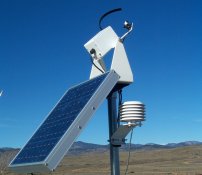Data sets currently available on SRRL RSP1 web site
- Daily plots and raw data files, are available from October 12, 2001 to June 19, 2007.
- Solar Calendars, are available from October 2001 to June 2007.
- Instrument history and meta data.
*** Notice: The "correction" applied to the irradiance data from this instrument (Version 1) is flawed. The data labeled "uncorrected" is more accurate. This instrument was shutdown on June 19, 2007. ***
A rotating shadowband pyranometer (RSP) offers a low cost option of measuring solar radiation resources for renewable energy applications. The RSP uses a silicon-based photodiode to measure the global and diffuse solar irradiance. The control and data acquisition system computes the corresponding direct normal solar irradiance based on the geographic location of the RSP and the time of the data collection events.
The National Renewable Energy Laboratory (NREL) has obtained an RSP from Schott in October 2001. The instrument was installed at the Solar Radiation Research Laboratory (SRRL). The long-term performance of the RSP will be compared to traditional thermopile-based radiometers and the ATI RSP located at SRRL. Note: This instrument was upgraded to an RSR version 2 by Irradiance Inc. on June 19, 2007.
By design, the RSPs offer the potential advantages of lower maintenance and calibration costs because they use a single instrument with a diffuser for determining the direct, diffuse, and global solar irradiance rather than up to three radiometers with larger optical surfaces, more complex support equipment, or more maintenance-intensive support equipment. Their potential disadvantage is the higher estimated measurement uncertainty because of factors such as the restricted spectral response of the silicon-based detector used in the RSP. Postprocessing software to account for the limited spectral response of the silicon detector could also be developed and applied the RSP data. Because the RSPs have moving parts, they should be periodically checked for slipping.
